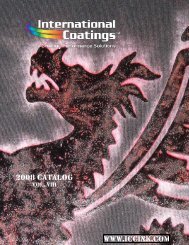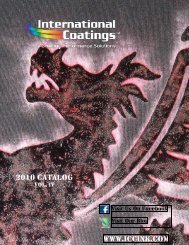2008 CATALOG WWW.ICCINK.COM
2008 CATALOG WWW.ICCINK.COM
2008 CATALOG WWW.ICCINK.COM
Create successful ePaper yourself
Turn your PDF publications into a flip-book with our unique Google optimized e-Paper software.
Q. – Is there a way to test the ink for complete cure?<br />
A. -- Adhesion of the properly catalyzed 900 ink will be at its best 24 to 72 hours after heat curing.<br />
Wash testing a printed piece of fabric is the best method of testing for proper adhesion.<br />
Q. – How long have the 900 Series Nylon Inks been on the market?<br />
A. – The 900 Series has been on the market for 15 plus years and is the most widely used direct<br />
print nylon ink in screen printing today. The 900 Series System consists of a specifically<br />
formulated plastisol, used in conjunction with a special 900LF Catalyst, which when properly<br />
mixed with the ink will adhere to most non-waterproof nylon fabrics. Once mixed together,<br />
the ink and catalyst will stay usable for 6 to 8 hours. Once the printing is finished, any<br />
screens and squeegees used with the inks should be thoroughly cleaned with a low V.O.C.<br />
screen wash.<br />
Q. – What is the ratio of 900LF Catalyst to 900 Series Ink?<br />
A. -- By Weight: 20 parts 900 Series Ink to 1 part 900LF Catalyst<br />
By Volume: 16 parts 900 Series Ink to 1 part 900LF Catalyst<br />
It is highly recommended that a gram scale be used for quick and accurate mixing of<br />
catalyst to ink. A scale helps to speed up mixing and prevent waste by allowing smaller<br />
portions of ink to be mixed accurately. International Coatings has available an electronic<br />
gram scale perfect for nylon ink users. The V-3000 Electronic Scale, $140.00, can be used<br />
to accurately mix ½ pints to quarts of nylon ink. Mixing by volume is easy, but is not as<br />
accurate as mixing by weight and this generally leads to using too much catalyst. By<br />
volume, when using 2 oz. bottles, use ¼ bottle (½ fluid ounce) for a ½ pint of nylon ink: ½<br />
bottle (1 fluid ounce) for pint of nylon ink and the 2 ounce bottle for a quart of nylon ink.<br />
Q. – What type of squeegee should be used when printing nylon?<br />
A. -- A triple durometer squeegee is recommended. This type of squeegee will allow you to lay<br />
down an even, thin ink deposit. This is important because the thinner and more even ink<br />
deposit produces a much better print. The other advantage to a thin, more even ink deposit<br />
is quicker flash times and faster ink fusion through the dryer. For dark nylon fabric use a 60-<br />
90-60-durometer squeegee. For light colored nylon fabric use a 70-90-70-durometer<br />
squeegee.<br />
Q. – Is it necessary to catalyze all the inks when printing a multicolor nylon design?<br />
A. -- When printing directly over the top of 900 Series Catalyzed Ink, it is not necessary to<br />
catalyze the inks used on top of another catalyzed ink. If the colors are not printed directly<br />
over the top of catalyzed ink, then each ink color used must be catalyzed.<br />
Recommendations and statements made are based on International Coatings research and experience. Since<br />
International Coatings does not have any control over the conditions of use or storage of the product sold, International<br />
Coatings cannot guarantee the results obtained through use of its’ products. All products are sold and samples given<br />
without any representation of warranty, expressed or implied, of fitness for any particular purpose or otherwise, and upon<br />
condition that the buyer shall determine the suitability of the product for its own purpose. This applies also where rights of<br />
third parties are involved. It does not release the user from the obligation to test the suitability of the product for the<br />
intended purpose and application. Rev72600<br />
6<br />
119




